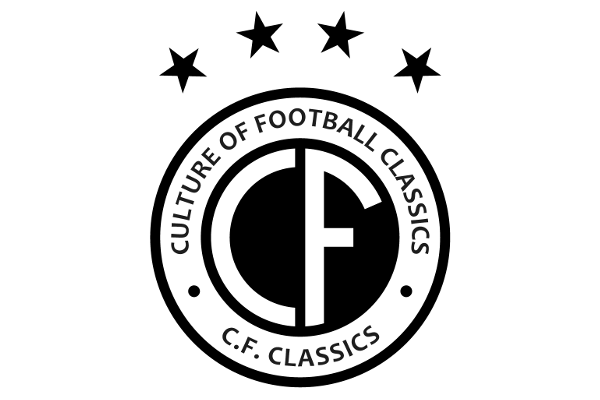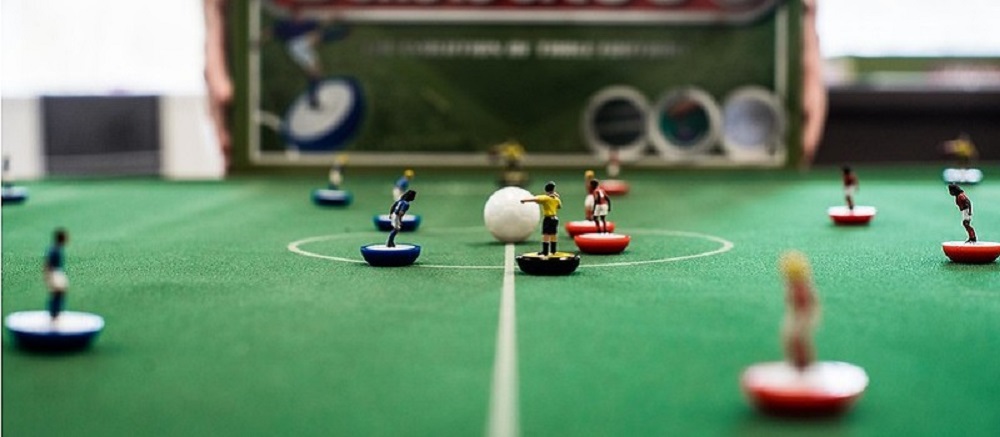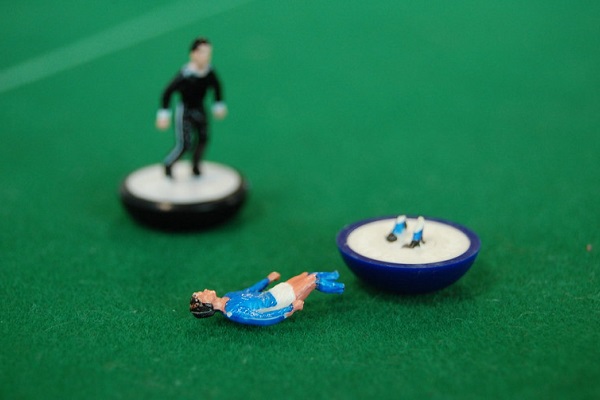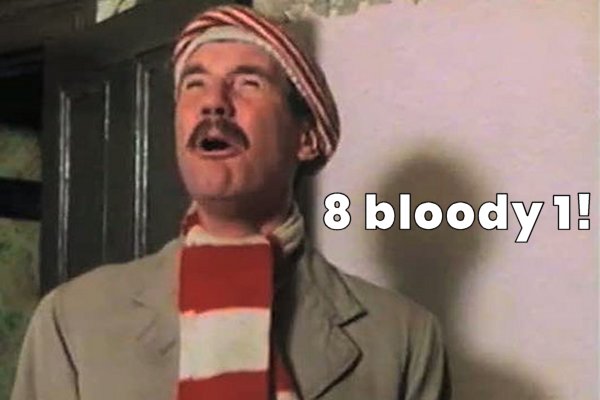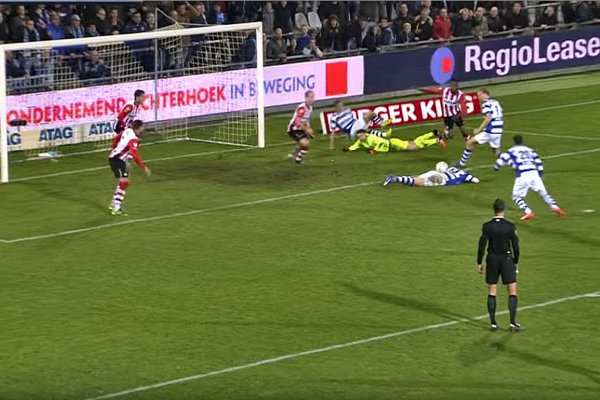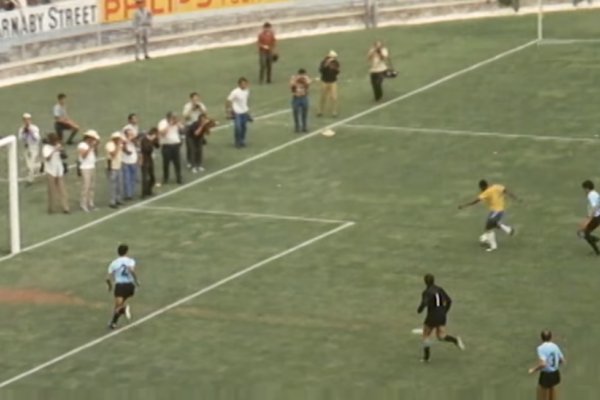20 things to love about Subbuteo
No.1 The Players and Kits
Where else could we start but with the base and figure that made Subbuteo players so iconic. That semi-circular base, with the player stood there, arms hanging down, is just beautiful. Then add to that the fantastic array of kits and there's no wonder that we were all hooked simply by the look of it.
All the figures and kits were actually handmade and hand-painted right up to the late 1970s, so they genuinely were a work of art. Nothing could beat seeing an iconic kit, such as Peru or Brazil, in miniature form, lined up on a Subbuteo pitch.
The great thing with some of the Subbuteo kits is that they could represent multiple teams. For instance, team LW689 had orange shirts and white shorts, so you could use it as Holland for international matches, Blackpool for English league matches, or Volendam if you wanted to go continental. So, looking at the list of possible teams on the outside of the box became a key factor when deciding which kit to buy next.
No.2 The Accessories
This is what set Subbuteo apart from everything else, the level of detail you could go into with all of the accessories was incredible, unrivalled for any other game of its kind, including the likes of Scaletrix.
Not only were there the obvious accessories, such as different goals (square, continental nets anyone?) and replica balls, but also the more expensive pieces such as stadium terracing, grandstands, floodlights and scoreboards. Everything had been thought of - there was even a TV gantry set, referees and linesmen, a subs bench, you could even get Ken Baily (complete with rattle), the famous cheerleader who followed England around for decades. And then there were the really detailed accessories such as the little transfers for shirt numbers, corner flags, and football trophies. The range of Subbuteo extras that were available was simply brilliant.
Floodlights were the absolute pinnacle of all the accessories, and whilst no-one you knew ever owned them, they were in most of the adverts, looking absolutely magnificent all set up for a night match!
Whilst the accessories undoubtedly looked beautiful, many of them often made the game harder to play. So, whilst having a set of the two-tiered stands and fencing running down the length of the pitch looked amazing, it made it harder to lean over and flick the players, and knocking the stand would often result in plastic supporters tumbling down the stand into a heap at the bottom on their backs.
Recent years has seen an influx of new accessories, with the advent of 3D printers meaning that Subbuteo enthusiasts could even start creating their own accessories.
No.3 The Subbuteo Shop
And where were all the accessories bought from back then? The Subbuteo shop. Every decent-sized town and city usually had one, normally in the form of a really good toy shop or even a large independent sports shop. So, for instance, if you grew up in Sheffield, you could pop into the fantastic Redgates toy shop and see all the Subbuteo stuff alongside Scaletrix and Hornby train-sets, or you could go into Sugg Sports and see all the Subbuteo gear next to their array of football shirts. And was there ever a better sight than a shop with a mass of Subbuteo teams to select from? Quite literally, a beautiful, magnificent wall of those green boxes. Often the wall of green was so big that the shop assistant might have to get a step ladder out to reach a specific team box from the top of the pile.
Collecting teams and accessories became an obsession for many kids, and it actually made going into town with your mum bearable if you'd saved up enough money to add something to your Subbuteo collection.
No.4 Broken Players
Summed up perfectly in the lyrics of the great Half Man Half Biscuit song, "All I Want For Christmas Is A Dukla Prague Away Kit"...
"You'd always get palmed off with a headless centre forward, and a goalkeeper with no arms and a face like his".
Yes, no matter how much you tried to look after your teams, there were always casualties. And it wasn't from flicking them too hard, but usually from an accidental hand squashing your favourite defender, or kneeling on your star forward as you crept around the pitch, or standing on a player who you didn't realise had come off the pitch. There were even cases when our cat wiped out players after invading the pitch.
Trying to fix snapped players was a futile exercise. Glueing them was the obvious choice, but unless you'd discovered the epoxy-power of Araldite then nothing else was strong enough. Another trick was to get the soldering-iron out, melt both the broken ends and then push them together. A successful remoulding made you feel like you'd achieved some sort of micro-sized plastic-surgery. The melting power of the soldering-iron also meant that you could attempt to remould the shape of certain players for a touch more realism - we once heated up the legs of a West German player to give him the bandy-legged appearance of Pierre Littbarski!
No.5 The Footballs
Oh my, the little replica Subbuteo footballs looked so good. The mini adidas Tangos, especially the coloured ones, were particularly desirable. And those Italia '90 balls - wow! Even some of the more obscure balls were available as miniature replicas, for instance the Ennerre Tamer that was used in Serie A, or the NASL ball, complete with the star design, that had been used in the United States.
It was great when your Subbuteo players hit one of these replica beauties into the back of the net, but to be honest it was also really satisfying just pinging them into an empty net with your finger, or popping them off the full length of the pitch using the tip of your finger and using back spin to return them back into the goal! Happy days indeed.
No.6 The Playing Surface
Incredibly, Subbuteo started out in its very early days being played on surplus army blankets. The game came supplied with some chalk and the instructions told you how to draw the pitch markings onto the blanket!
Over time, the famous green pitch was supplied with the sets, complete with pre-printed pitch markings. However, this wasn't without issues either - not putting the pitch away neatly enough (i.e. leaving it in a wrinkled mess, crammed into the box) or even folding it away too tightly, would eventually lead to the pitch needing to be ironed by your mum. Ironing and constantly pulling the pitch into position eventually stretched it so much that it was no longer exactly rectangular, giving the appearance that the pitch had been marked out by someone who'd had a proper session the night before.
Even though Subbuteo was described as table-top football, it was often played on the floor (not everyone had a table big enough), and different carpets would give a totally different feel to the playing surface when it was laid on top of it.
And for the rich kids out there, or the real experts who played at county level (we all knew someone who claimed this), there was the Subbuteo Astropitch. It came in a tube. It was thick enough to roll up. It didn't crease (allowing free-flowing passing moves). But, it was bloody expensive!
No.7 The Stadium
Subbuteo sets have always looked great throughout the years, but none more so than when they had parts of a stadium surrounding the pitch. Oh my, they looked so good. The two-tier stands, or the open terracing, the scoreboard, the mythical floodlights, it all looked fantastic. But they were expensive too, so you were lucky to have any at all, the most likely opportunity being as a Christmas or birthday treat. Unfortunately, having only have a few stands didn't look quite the same as those glorious TV adverts, and resembled a non-league stadium, rather than Wembley.
And to go in the stadiums, there were packs of little plastic fans. They were unpainted, which, if you couldn't be bothered to hand paint them, gave the appearance that about a hundred fans had decided to come along to the match without any clothes on. Fed up with these fans constantly falling down the stands after even the slightest accidental knock, the glue would be out again to permanently fix them in place.
The main thing with Subbuteo stadiums though, was the never-ending trade-off between having something that looked amazing versus something that was easy to play on. So, if someone was lucky enough to have a few stands, or if a few of you had one each so you could then put them together to form half a stadium, the thing that soon became apparent for a group of seven year-old kids was that it was really hard to play around, leaning over the stand at an awkward angle, or trying to get your arm around the scoreboard without disturbing it. The problem was amplified if you were having to play on the floor. To get the best of both worlds, our trick was to have the stands there at the start, pushing the players through the tunnel, lining them up in front of the stand(s), before moving them out of the way so we could get on with the game. It was a decent compromise, although deep down we all desired the full stadium-in-the-loft setup that we'd seen in Shoot! magazine.
No.8 Rainy Days
Before the days of FIFA, Pro-Evolution, Match Day or even Football Manager, if it was hammering it down with rain outside and you couldn't play actual football in the park, then Subbuteo provided you with a decent alternative to get your daily fix of footy. In fact, it was more than a decent alternative, with all of the accessories it felt like you could bring the professional game into your house, and so, for the first time, the occasional rainy day didn't actually matter too much.
No.9 The Obscure Teams
Summed up perfectly again by the Half Man Half Biscuit song, "All I want for Christmas is a Dukla Prague Away Kit". Scanning over the green wall of boxes in the local Subbuteo shop would open your eyes to a whole new world of obscure European and South American club teams who you'd never heard of before.
Shops would sometimes have little Subbuteo catalogues with a list of all the teams in, so you'd be wondering how good Wacker Innsbruck were, or discovering that Winterthur played in the Swiss league, it was almost educational, an interesting way to learn a bit of geography! Kits covering multiple clubs also meant that if you bought a certain team then you could also play as teams you'd not heard of, so if you were an Ipswich Town fan then suddenly you'd find yourself playing friends as Schalke 04, or Saarbrucken. Some of us even formed allegiances to teams that would last forever!
No.10 The Branding
So simple, but so effective. That pill-shaped design, with the white lettering and the red and green background colours, topped off with the iconic Subbuteo figure symbol. Absolutely mint.
No.11 "Away" Matches at a Friend's House
You knew when you were really hooked on Subbuteo when you agreed to go and play an "away" match at someone else's house. Which team you would choose to take was normally an easy decision. You always had a favourite team to play as. Your top team. In your head they'd never been beaten, you always played better with them, so in many cases you'd take your top team to the away match. There were exceptions though. If you knew that the other kid was definitely going to beat you (and remember, there was always one person who had the reputation that "they've never lost at home") then you'd sometimes opt not to take your top team so that you could keep their unbeaten status intact.
Whilst most of us would just take our team in their normal, original box, some rich kid would let their players travel in style, with a special felt-lined carry case. When you got there, the normal routine was that the kid playing at home would decide how get the advantage of how long would be played, and exactly what rules were being played (despite the box having instructions, there always seemed to be slight rule changes at different houses!). If you were lucky then one of you would have one of the mini replica trophies to play for, making the match all the more special and adding a bit more pressure to the occasion. And if there were a few of you on the street who played then you'd set up a mini league to keep a record of all the home and away fixtures.
To be fair, even if you had no one to play against it was just great lining the teams up, or setting up different formations, trying set pieces, re-enacting great goals etc. You soon start considering yourself the Bielsa of the Subbuteo cloth.
No.12 The Subbuteo Box
We're not necessarily talking about the actual original Subbuteo box that a set came in, although it could well include that too, but more the general box that you kept all of your Subbuteo stuff in when you weren't playing it.
It was like a treasure trove every time you got it out and opened it up, seeing all of the accessories and boxes of teams all packed into it. There would be, of course, a look of horror across your face when you saw the state of the pitch - usually creased to hell having been squashed in with the other stuff the last time you packed it away.
These boxes were sometimes handed down between siblings, relations and neighbours, when kids got to a certain age and their mum (mistakenly) thought they'd outgrown it, which then lead to a show of outrage when you found out years later, having decided to set it all up again!
The hand-me-down boxes kind of summed up Subbuteo - they were always a classic combination of mainstream accessories and teams along with some random accessories you'd never come across before and one or two completely obscure European and South American teams!
If you did happen to still have the original box then it would most likely be the "Subbuteo Club Edition", the standard package featuring a red and white team and a blue and white team. If you were lucky then you might get a special edition box, for instance one of the World Cup editions. There were also some really unusual editions, such as a 5-aside version called Football Express where the box itself was used as the pitch, making it very portable! There was also an Indoor Soccer version with a white pitch. The hand-me-down might also contain other sports - Subbuteo crossed into several others, such as rugby, cricket and even angling!!
No.13 Customising
One of the great things about Subbuteo was the amount of accessories you could get, but the joys of changing or extending your set didn't just end there, there was plenty of potential for customising things yourself too.
For instance, whilst you could buy the corner-kick players as an official accessory in order to try and get some height on the ball, one friend just used a little wedge in front of the ball to achieve a similar result from corners, goal-kicks and free-kicks! The goals were easily customised too - a bit of coloured netting (orange onion bags anyone?) and then pinning them out at the back, soon had them looking much more like the cool continental goals than the standard British ones. And after Argentina '78 we even even wrapped a bit of black tape around the base of the goalposts to copy what we'd seen there!
And then came the customising of the players - painting on a beard to create Paul Breitner, or a moustache for Graeme Souness, a headband to create a realistic Socrates (or Steve Foster), and even getting the black marker pen out to replicate Giuseppe Bergomi's eyebrows!
Even the pitch wasn't off-limit for a bit of customisation. The standard thing to try and do with the pitch was attempt to permanently mount it on something big enough so that you didn't have to fold it up, meaning that you would no longer suffer the dreaded creases. However, not only was it almost impossible to find something big enough that would stay completely flat (lots of us tried hardboard and thick card but it would always bend up in places), but how many people actually had the room to store such a massive item? The only person with enough room was the rich kid in the big house, and they often had enough room to have it setup on a table in a spare room anyway! So, the rest of us were stuck with using books to try and keep the pitch in place, but there were still other opportunities for a bit of pitch customisation - for instance, using a bit of your dad's white car spray repair paint to cover sections of the pitch in order to look like it had snowed, giving the perfect excuse to play with the orange ball!
No.14 The Adverts
Subbuteo always looked so good in the adverts. In particular, the TV adverts. If there was a list of greatest football theme tunes for adverts, then this would undoubtedly be at the top....
"Subbuteo! Oh-oh-oh-oh! Subbuteo! Oh-oh-oh-oh! Subbuteo, the champion game of all."
The adverts were shown almost constantly every Saturday morning in the run up to Christmas, during the breaks for the likes of Tiswas and No.73. They looked brilliant too - the floodlit Stadiums packed to the rafters with little plastic supporters, on a pristine tabletop surface, with some cheeky young scamp lashing a cracking shot past a despairing keeper.
The magazine adverts were pretty good too. They'd started doing them in the late 1940s in "Boys Own" magazine, but by the 1980s they were regular fixtures in the likes of Shoot! and Match. The Subbuteo adverts always did their job - immediately making you want to go out and get another team or accessory.
No.15 The Floodlights
Aah, the mythical floodlights. When it came to Subbuteo extras, these were the pinnacle, the holy grail of accessories. Unfortunately, no one we knew ever had them, they were just seen on the TV adverts. And so the dream of playing a night match on a floodlit pitch remained just that - a dream.
No.16 The Scoreboard
The giant black scoreboard, another iconic Subbuteo accessory. The team names, along with a list of competitions, all came on a black sheet that you cut out and then slid into place onto the scoreboard. The joy of seeing your team's name up there, and spinning the score round when you scored, was a real treat.
No.17 House Rules
We're not sure if this was just local to our area or not, but one of the things you could guarantee when you went to play Subbuteo at somebody else's house (an away match) is that they'd have slightly different rules to what you were used to playing at home.
We don't remember ever actually reading the exact rules as a six year old, but everyone seemed to have slight variations on what was allowed and what wasn't. For example, even though you were used to the rule of only having three flicks in a row, you'd go to someone's house and they'd insist it was four, whilst someone else would insist that pushing was allowed on their turf, not just flicking.
And then there was the length of the half - you'd go to one house and he was wanting to play a quick-fire ten minute half, whilst a few houses down the road another lad would insist on a full ninety minutes!
In practice it seemed to work quite well because it did give the player a slight home advantage, which all added to the realism of a tricky away game.
No.18 Set Pieces
Allowing quirky set pieces was often a key feature of the house rules for different friends. And it was often down to what accessories they might have at their disposal. So, someone might have one of the hinged corner kickers that you flicked back their head and their foot would sweep through the ball and actually lift it. However, as no Subbuteo player was actually capable of heading the ball your best bet was normally just doing short corners. The corner kickers did have their use though - direct free-kicks. Their ability to get under the ball meant that you could attempt to emulate Zico chipping it into the top corner past Alan Rough. If you went to someone's house and they had an accessory like this, the standard practice was that you could also use it, but you did have the disadvantage that your mate had probably been practicing with it for an hour the night before.
Some people had throw-in takers on springs, which were like mini Rory Delaps, allowing you to arrow the balls goalwards like a plastic cannonball, causing carnage in the penalty area if any Subbuteo players dared get in its way!
And then there were penalties. Good grief, they were as nerve-racking as the real thing - waiting to take it as your opponent rattled his keeper round like Grobelaar on acid or laid him down flat before the kick had been taken to fill the goal line as much as possible! And it was almost impossible to try and hide which side you were aiming for as the angle of the run up gave it away. The best tactic seemed to be to hammer it as hard as possible, Ray Stewart style, the penalty-taker would invariably end up in the net, you just had to hope that the ball also found its way in there too!
Another set-piece option we used to decide tied-games was the NASL-style penalty, your favourite player starting with the ball at the halfway line and having to negotiate his way to the penalty box without missing the ball, before trying to score passed the keeper who was now completely off his line, your mate's fingers stretching through the back of the goal as far as possible to close the angle as much as he could!
No.19 The Continental Goals
One of things that always struck us whilst watching European football matches on TV in the late 1970s and early 1980s was the beauty of the continental goals and nets compared to those used in British grounds. So, all of a sudden, Subbuteo let us live the continental dream, either buying some proper continental ones or just customising the standard ones by pinning the nets to something behind them to make them look square and then borrowing your dad's car spray-paint to change the colour of the nets.
No.20 The Enormous Scale
We loved the the mix of true scale and outrageous scale in the Subbuteo sets. So whilst most of the scales for the accessories were pretty much spot on, there were huge differences in some things - like the balls or the trophies, which were often bigger than the players themselves!
Tweet
